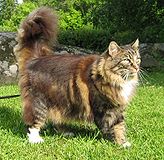|
Norwegian Forest Cat
History A common belief among cat fanciers is the Norwegian Forest Cat breed is centuries old in its native homeland, Northern Europe. How long Forest Cats have existed in Norway no one knows.
Some say these cats may be descendants of shorthaired cats brought from England by the Vikings and longhaired cats brought in by the Crusaders. They don't have the look of Persians or other longhaired shorthair cats. They are a very special cat breed.
The harsh Norwegian climate is very hard on humans, but it has been a blessing to the cats. The Norwegian Forest Cat has become the cat it is today because only the fittest survive the harsh climate. These cats had to feed and defend themselves from natural predators in the forests.
Only the ones who were best at hunting and fast to escape from predators survived. Cats who lived through their first winter were long legged, springy, intelligent and brave. Thus a very special breed of cat evolved without any human interference.
In Norway these cats are known as the skogkatt/skaukatt which means forest cat ("skog" and "skau", alternate words for "forest" in different Norwegian dialects) or more formally as the Norsk Skogkatt (Norwegian Forest Cat). Also commonly named Weegie.
Norse mythology relates there was a cat so large even the legendary god Thor could not pick the cat up the ground. More folk lore has it Freya, goddess of Love and Fertility, had her carriage pulled by two huge cats. National fairy tales composed by Asbjomsen and Moe talk of Troll Cats who were huge and furry.
Translations in later years changed Troll Cats to Forest Cat. The year of 1912, Gabriel Scott, a well recognized Norwegian poet, wrote an complete book about a white Forest Cat "Snowflaks" who was mobbed by other cats because "Snowflaks" was longhaired.
The Forest Cat was considered just a domestic cat like any other cat in Norway. People did not care about this longhaired stray cat except the farmer, who appreciated this big, beautiful, domestic cat. Forest Cats are still be found on farms in Norway.
This lynx-like cat was called the "Skaukatt" by the populace who knew about the cats existence. In the late 1930s, a small number of 'Skaukatts' were shown in Germany and received very favorably by the judges.
World War II brought a sudden end to the fledgling Norwegian cat show industry and the breed was forgotten until the 1970s. The cats are now being bred and shown in several countries including the United States. The first international association to accept the breed was Fédération Internationale Féline (FIFe), in 1977.
It has been said The Norwegian Forest Cat is the early ancestor of the Maine Coon Cat and the long-haired Manx Cat.
Description
Norwegian Forest Cats have a thick fluffy double-layered coat, long tufts of fur in ears, between toes and a long bushy tail to protect them against the cold. Their coat is essentially waterproof due to its water repellent outer layer and dense underlay.
The ruff in winter is truly magnificent, exhibiting three separate sections: a short back of the neck ruff, side mutton chops and a full frontal bib. When feeling the fur, one should get the feeling of denseness especially on the tabbies.
The length of the coat is semi-long meaning it should not be as long as a Persian Cats coat.
Norwegian Forest Cats are a big and strongly built cat with a medium length body and hind logs higher than the front legs. It is muscular and heavy boned. The head is triangular shaped with all three sides equal.
The profile is long and straight with no break, stop or bump.The cat has a strong chin. The eyes are extremely expressive, large and almond shaped set at a slight angle with the outer comer slightly higher than the inner comer.
All eye colors are accepted including blue and odd-eyed whites. The ears are medium large, set on the head so that they follow the line of the triangle from the outer base of the ears down to the chin.
The ears are well tufted and many of the cats have lynx-like tips. The tail is long and flowing and carried high. The Norwegian Forest Cat comes in every color but color pointed.
Adult males weighing 6 to 10 kg (13 to 22 lb) and females are approximately half the size of the male. Their back legs are longer than their front legs. They are very intelligent, playful cats who enjoy human compainship but may become upset if left alone for long periods of time.
he nickname of "Wegie" (pronounced to rhyme with 'squeegee') started in the United States.It is a shortened version of the word Norwegian.
Behavior
Similar to Maine Coon Cats, Norwegian Forest Cats are an intelligent, robust and playful breed of cat. They like the outdoors, are well suited to cold conditions and are great hunters. Despite their great affection for the outdoors, they enjoy the companionship of humans and other pets. If left alone by their owners they sometimes go looking for company.
Not easily stressed and are quite patient makes them great for a family with children. They like high vantage points and enjoy climbing trees. If they are an indoor cat they climb on appliances, bookshelves and other elevated surfaces in the home.
Norwegian Forest Cats are wondeful family pets and do not require much maintenance. A combing at least once a week, without their fur can become knotted and tangled. Describing the Forest Cat, the most prominent characteristic is their disposition.
They are extremely loyal and good talkers. Their purr boxes are constantly working and they continually-exhibit their love of people. If they have a fault, it is they want to be with you and love you all the time. Hard to beat that! Abyssianian Cat
|





